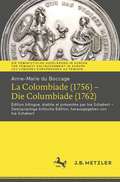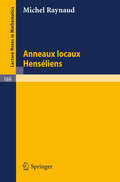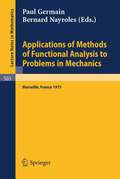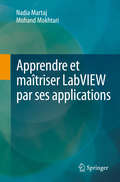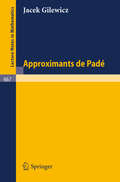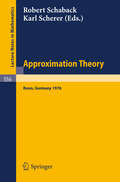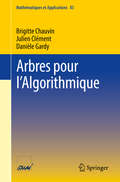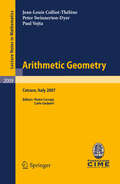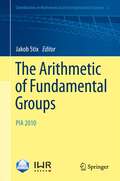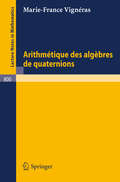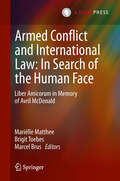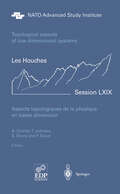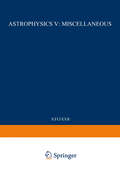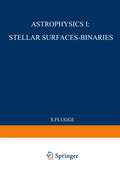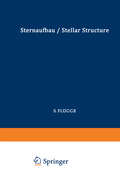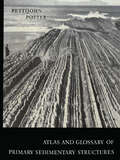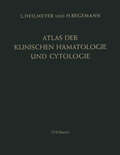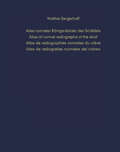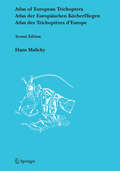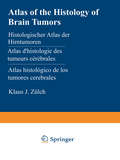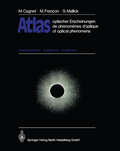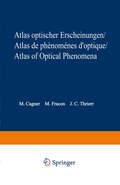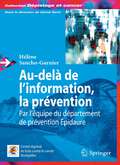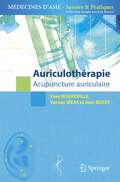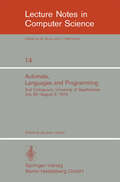- Table View
- List View
Anne-Marie du Boccage: Édition bilingue, établie et présentée par Ina Schabert – Zweisprachige kritische Edition, herausgegeben von Ina Schabert (Die Feministische Aufklärung in Europa | The Feminist Enlightenment in Europe | Les Lumières européennes au féminin)
by Anne-Marie du BoccageLa Colombiade war bis zur französischen Revolution ein in Frankreich und in den westeuropäischen Ländern vielbeachtetes Epos. Aus heutiger Sicht ist das gut lesbare Gedicht erneut von Interesse: es wägt Segnungen und Schäden der Kolonialisierung gegeneinander ab, propagiert die Idee eines auf wissenschaftlichem und humanistischem Ethos gegründeten Europas, und artikuliert das aufklärerische Selbstbewusstsein einer schreibenden Frau. Die Einführung der Herausgeberin stellt das Gedicht in den Wissenshorizont der Entstehungszeit und skizziert die Rezeption. Der Anhang informiert über Textvarianten, bringt erläuternde Anmerkungen und einen bibliographischen Informationsteil.
Applications of Methods of Functional Analysis to Problems in Mechanics: Joint Symposium IUTAM/IMU held in Marseille, Sept. 1-6, 1975 (Lecture Notes in Mathematics #503)
by P. Germain B. NayrolesApprendre et maîtriser LabVIEW par ses applications
by Nadia Martaj Mohand MokhtariCet ouvrage traite de l’apprentissage du langage LabVIEW à travers ses applications dans des domaines industriels et académiques, qui permettront à l’ingénieur, technicien ou étudiant d’appréhender rapidement et efficacement ce langage. L’ouvrage commence, dans la partie I, par traiter les différents types de données du langage LabVIEW (tableaux, clusters, complexes, chaînes de caractères…), leur manipulation dans des structures d’exécution (boucles While, For, la structure Condition, etc.), le langage textuel MathScript, des scripts Matlab, la boîte de calcul utilisant la syntaxe du langage C ainsi que les nœuds de propriété qui permettent d’obtenir ou définir la propriété d'un VI. Cette étude est menée à travers des applications d’ingénierie.La partie II est consacrée à l’étude de l’outil « Conception de contrôle et simulation » avec lequel nous pouvons simuler des systèmes analogiques ou discrets.La partie III contient différentes applications qui traitent de nombreux thèmes comme la régulation (différentes structures du PID, les commandes RST, LQI, etc.), la logique floue, le traitement de signal (déterministe, aléatoire et filtrage adaptatif, etc.), le traitement des fichiers de mesure, la statistique expérimentale, etc.
Approximation Theory: Proceedings of an International Conference held at Bonn, Germany, June 8-11, 1976 (Lecture Notes in Mathematics #556)
by R. Schaback K. SchererArbres pour l’Algorithmique (Mathématiques et Applications #83)
by Danièle Gardy Julien Clément Brigitte ChauvinCet ouvrage présente les types d'arbres les plus utilisés en informatique, sous les angles algorithmique et mathématique. Pour chaque type, nous donnons les algorithmes courants associés et des exemples d'utilisation, directe ou en modélisation, puis nous étudions leurs performances d'un point de vue mathématique. Nos outils sont les mathématiques discrètes, les probabilités et la combinatoire analytique, présentés ici simultanément.Le public visé est d'abord celui des étudiants de niveau master scientifique ou en dernière année d’école d’ingénieurs avec un cursus préalable en informatique ou en mathématiques, ou ceux visant une double compétence en mathématiques et informatique ; ainsi que toute personne dotée d’un bagage scientifique « minimal » et amenée à utiliser des structures arborescentes liées à des algorithmes, qui souhaiterait avoir une meilleure connaissance de ces structures et une idée des performances des algorithmes associés sans se plonger dans les travaux originaux. This book presents a wide range of tree structures, from both a computer science and a mathematical point of view. For each of these structures we give the algorithms that allow us to visit or update the structure, and discuss their potential uses, either directly (for storing data) or in modelling a variety of situations. We present a mathematical approach to their performances; this is done by the systematic and parallel use of tools from discrete mathematics, probability and analytic combinatorics.The book is intended for graduate students in mathematics or computer science (or both) and in engineering schools. It is also suitable for anyone with a basic level of scientific knowledge who may have to use tree structures and related algorithms, and who wishes to get a rigorous knowledge of their performance without going back to the original, often specialized, results.
Arithmetic Geometry: Lectures given at the C.I.M.E. Summer School held in Cetraro, Italy, September 10-15, 2007 (Lecture Notes in Mathematics #2009)
by Jean-Louis Colliot-Thélène Peter Swinnerton-Dyer Paul VojtaArithmetic Geometry can be defined as the part of Algebraic Geometry connected with the study of algebraic varieties through arbitrary rings, in particular through non-algebraically closed fields. It lies at the intersection between classical algebraic geometry and number theory. A C.I.M.E. Summer School devoted to arithmetic geometry was held in Cetraro, Italy in September 2007, and presented some of the most interesting new developments in arithmetic geometry. This book collects the lecture notes which were written up by the speakers. The main topics concern diophantine equations, local-global principles, diophantine approximation and its relations to Nevanlinna theory, and rationally connected varieties. The book is divided into three parts, corresponding to the courses given by J-L Colliot-Thelene, Peter Swinnerton Dyer and Paul Vojta.
The Arithmetic of Fundamental Groups: PIA 2010 (Contributions in Mathematical and Computational Sciences #2)
by Jakob StixIn the more than 100 years since the fundamental group was first introduced by Henri Poincaré it has evolved to play an important role in different areas of mathematics. Originally conceived as part of algebraic topology, this essential concept and its analogies have found numerous applications in mathematics that are still being investigated today, and which are explored in this volume, the result of a meeting at Heidelberg University that brought together mathematicians who use or study fundamental groups in their work with an eye towards applications in arithmetic. The book acknowledges the varied incarnations of the fundamental group: pro-finite, ℓ-adic, p-adic, pro-algebraic and motivic. It explores a wealth of topics that range from anabelian geometry (in particular the section conjecture), the ℓ-adic polylogarithm, gonality questions of modular curves, vector bundles in connection with monodromy, and relative pro-algebraic completions, to a motivic version of Minhyong Kim's non-abelian Chabauty method and p-adic integration after Coleman. The editor has also included the abstracts of all the talks given at the Heidelberg meeting, as well as the notes on Coleman integration and on Grothendieck's fundamental group with a view towards anabelian geometry taken from a series of introductory lectures given by Amnon Besser and Tamás Szamuely, respectively.
Armed Conflict and International Law: Liber Amicorum in Memory of Avril McDonald
by Mariëlle Matthee, Brigit Toebes and Marcel BrusThis book is written in memory of Avril McDonald, who passed away in April 2010. Avril was an inspired and passionate scholar in the fields of international humanitarian law, international criminal law, human rights law and law in the field of arms control and disarmament. What in particular made Avril’s work special, was her strong commitment with the human aspects throughout. Fourteen scholars and practitioners have contributed to this liber amicorum, which has led to a rich variety of topics within the disciplines of Avril’s expertise. They all have in common that they deal with the human perspectives of the discipline of law at hand. They concentrate on the impact of the developments in international law on humans, whether they are civilians, victims of war or soldiers. This human perspective of law makes this book an appropriate tribute to Avril McDonald and at the same time a unique and valuable contribution to international legal research in the present society. A society that becomes more and more characterized by detailed legal systems, defined by institutions that may frequently lack sufficient contact with the people concerned.
Aspects topologiques de la physique en basse dimension. Topological aspects of low dimensional systems (Les Houches - Ecole d'Ete de Physique Theorique #69)
by A. Comtet T. Jolicoeur S. Ouvry F. DavidSession LXIX. 7 - 31 July 1998
Astrophysics V: Miscellaneous / Astrophysik V: Verschiedenes (Handbuch der Physik Encyclopedia of Physics #11 / 54)
by S. FlüggeAstrophysik I: Sternoberflächen-Doppelsterne / Astrophysics I: Stellar-Surfaces-Binaries (Handbuch der Physik Encyclopedia of Physics #11 / 50)
by S. FlüggeAstrophysik II: Sternaufbau / Astrophysics II: Stellar Structure (Handbuch der Physik Encyclopedia of Physics #11 / 51)
by Marshal H. Wrubel H. C. Arp G. R. Burbidge E. Margaret Burbidge Hans E. Suess Harold C. Urey Lawrence H. Aller P. Ledoux Th. Walraven Armin J. Deutsch E. Schatzman Cecilia Payne-Gaposchkin F. ZwickySects. 12, 13. 89 sequence and that subgiant and fainter stars in globular clusters have ultraviolet excesses. When dealing with stars whose physical properties are imperfectly under stood, such as in globular cluster stars, we cannot rely too heavily on the empiri cal calibration by the kinds of stars used to define Fig. 5, to determine their true, unreddened U-B, B-V curve. But if by a combination of arguments, principally the reddening in the region of the stars we do known about, we can assign a fairly probable unreddened U-B, B-V curve to a group of stars about which we know little, the argument may be turned around. In this case some information may be gained about the energy envelope of the stars by examining the differences between the normal two-color index curves for the unknown group of stars compared to the known. In general there seem to be two possible causes for different stars defining different normal sequences in the U-B, B-V plane. One, the relative energy distribution in the continuum in the U, B and V photometry bands are different. An example of this is the effect of the Balmer depression in supergiants. This, of course, requires deviation from black body radiation curves for one or both groups of stars. This cause seems to be the dominant effect for very blue, hot stars where the depression of the continuum by absorption lines is at a minimum.
Atlas and Glossary of Primary Sedimentary Structures
by F. J. Pettijohn P. E. PotterInadequate observation of sedimentary TRUSHKovA and KUKHARENKO'S "Atlas of structures has been responsible for incorrect Placer Minerals." The most comprehensive interpretation of the order of superposition atlas is the "Atlas of Textures and Struc in deformed beds and this has led, in turn, tures of Sedimentary Rocks" edited by A. to gross errors in stratigraphy and structure. V. KHABAKOV (1962). Failure to recognize and utilize those Our Atlas is an outgrowth of our work on structures which indicate direction of cur "Paleocurrents and Basin Analysis," a book rent flow has also led to incorrect, or at in which directional sedimentary structures least incomplete, understanding of basin are described and interpreted with special development. reference to the evolution of sedimentary We believe, therefore, that there is need for basins. That work, however, contains mini a work which constitutes a field guide to the mal photographic material - just enough study of these structures - a book in to give the reader some concept of the sedi which these structures, so difficult to mentary structures described.
Atlas der klinischen Hämatologie und Cytologie: In deutscher, englischer, französischer und spanischer Sprache
by Ludwig Heilmeyer H. BegemannDie diagnostischen Fortschritte der Ausstrichcytologie haben bisher nur ill beschei denem Umfang Eingang in die ärztliche Praxis gefunden. Ein wesentlicher Grund dafür ist die Tatsache, daß das vorhandene Abbildungsmaterial zu sehr typisiert wurde, um dem Anfänger eine Einarbeitung in dieses Gebiet zu ermöglichen. Die Ausmerzung dieses Mißstandes soll eine Hauptaufgabe des vorliegenden Buches sein. Aus diesem Grunde haben wir versucht, in den einleitenden Einzeltafeln und bei der Besprechung der einzelnen Krankheitsbilder durch Abbildung zahlreicher Übersichtstafeln die große morphologische Variationsbreite von Einzelzellen in Krankheitsbildern darzustellen. Mit Absicht wählten wir als Grundlage des Reproduktionsverfahrens das gemalte Bild: Ist schon die oft gerühmte photographische Objektivität für das Buntphoto höchst zweifelhaft, so geht diese bei der chemographischen Reproduktion von Buntphotos weitgehend verloren. Ein noch wichtigerer Grund ist der, daß das Mikrophoto praktisch nur eine Schichtebene scharf darstellen kann. Demgegenüber ist der mikroskopische Beobachter gewöhnt, durch fortwährendes Spiel mit der Mikrometerschraube verschiedene Ebenen zu be trachten und sich so ein plastisches Bild von der Zelle zu verschaffen. Die Möglichkeit, verschiedene Zellebenen gleichzeitig darzustellen, hat aber nur die Zeichnung, die dadurch den Verhältnissen der subjektiven Beobachtung näher kommt als das Photo. Auf die Schwarzweißdarstellung von Zellen haben wir bewußt verzichtet; ist doch die berechtigte Forderung der Histologen, den Lernenden von der Farbe ab- und auf die Struktur hin zulenken, bei der Ausstrichcytologie nur in wenigen Fällen erfüllbar. Die färberische Grundlage der gesamten Ausstrichcytologie bildet bisher die aus der Hämatologie über nommenen Färbemethoden.
Atlas normaler Röntgenbilder des Schädels / Atlas of normal radiographs of the skull / Atlas de radiographies normales du crâne / Atlas de radiografias normales del cráneo
by W. BergerhoffAtlas of European Trichoptera: Atlas der Europäischen Köcherfliegen / Atlas des Trichoptères d’Europe
by Hans MalickyCaddis flies are important indicators of environmental quality in aquatic biotopes. This Atlas is the first book which enables the identification of the entire European caddis fly fauna since McLachlan’s Revision and Synopsis of 1874-1880. Identification of European caddis flies has proved difficult as a result of the widely scattered literature, and has therefore been a matter for specialists for more than hundred years. This Second Edition of The Atlas of European Trichoptera contains over 1400 species which means an increase of 25% since the first edition of 1983. Identification of specimens is one of the most difficult tasks in Zoology. This volume presents information which will enable the reader to develop his own opinions and will also help him reach decisions concerning the accuracy of his own results. The identification of specimens is undertaken by comparing the detailed drawings of the most important characteristics of all species known in Europe, the Mediterranean countries north of the Sahara, the Canary islands, Madeira, the Azores islands and the adjacent eastern regions including the Arab Peninsula and Iran. The fauna of Turkistan and Siberia is partially included. Explanations of the drawings are provided mainly by symbols which enable the use of this book independent of language. This concept has been proved successful in University courses. The introductory chapters are in English, German and French. Should a reader not understand any of these languages, the translation of these few pages, including the pages of explanations, will provide sufficient understanding for the entire book.
Atlas of the Histology of Brain Tumors / Histologischer Atlas der Hirntumoren / Atlas d’histologie des tumeurs cérébrales / Atlas histológico de los tumores cerebrales / Гистологический атлас опухолей мозга человека: (pdf)
by K. J. ZülchAtlas optischer Erscheinungen / Atlas de phénomènes d’optique / Atlas of Optical Phenomena: Ergänzungsband · Supplément · Supplement
by Michel Cagnet M. Francon S. MallickAtlas optischer Erscheinungen / Atlas de phénomènes d’optique / Atlas of optical phenomena
by Michel Cagnet M. Francon J.C. ThrierrAu-delà de l'information, la prévention: Par l’équipe du département de prévention Épidaure (Dépistage et cancer)
by Hélène Sancho-Garnier Daniel SerinLa prévention des pathologies les plus fréquentes et les plus mortelles (cancers, maladies cardiovasculaires, accidents) passe essentiellement par la modification des comportements à risque, défi qui ne peut être résolu par la simple diffusion d’informations. Pour pouvoir modifier les comportements, il faut tenir compte d’une part, des individus eux-mêmes et de ce qui les amène à changer leurs manières de vivre et, d’autre part, de l’environnement culturel, social, physique et économique qui façonne les personnes et dont les modifications sont nécessaires aux changements individuels. Ainsi, les actions de prévention en matière de santé sont efficaces pour autant qu’elles renforcent la capacité à exercer un contrôle sur les déterminants de santé individuels et collectifs. Pour être plus efficaces, les programmes doivent donc inclure des stratégies multiples dont l’objectif est à la fois de changer le contexte sociétal et de changer les valeurs de vie des individus. Le centre de prévention Épidaure, ouvert en 1988, a pour mission la prévention des cancers. Son équipe pluridisciplinaire organise son activité autour de trois axes : recherche en pédagogie et préventologie, formation dans les mêmes domaines et mise en place, avec divers partenaires, d’interventions de prévention. C’est le fruit de ces quinze années d’expérience que l’équipe d’Épidaure a voulu transmettre dans ce livre, une partie théorique sur les possibilités d’action sur les comportements et une partie plus pratique rapportant les expériences d’Épidaure et les réflexions qui en découlent. Le dernier chapitre traite de l’évaluation des actions de prévention, domaine encore assez peu exploré et qu’Épidaure s’efforce de mettre en place.
Auriculothérapie: Acupuncture auriculaire (Médecines d'Asie: Savoirs et Pratiques)
by Yves Rouxeville Yunsan Méas Jean BossyLe pavillon de l’oreille est un lieu privilégié pour observer et pour traiter les malades de façon réflexe. Il est doté à la fois d’une innervation particulièrement riche, et de brèves connexions avec les centres nerveux supérieurs. Il constitue à la fois un pavillon de lecture, pour observer les informations issues des organes et des terminaisons nerveuses de la peau et un pavillon de commande pour aider à corriger les informations anormales. C’est un poste de guet, placé en dérivation du tronc cérébral, sur le chemin reliant les organes et le cerveau. Il permet ainsi un juste contrôle et une intervention efficace. Dans ce traité médical d’Auriculothérapie, sont présentées les données historiques et scientifiques, les explications médicales et les références bibliographiques. Cependant, la partie la plus importante de l’ouvrage est réservée à la clinique et à la pratique. Le lecteur y est mené de façon progressive, depuis les situations simples et courantes vers les cas plus difficiles et complexes, sans jamais perdre une double vision : le survol panoramique et la recherche du détail. Bénéficiant d’un soutien universitaire de qualité, ce traité est appelé à devenir la référence incontournable pour la formation initiale en auriculothérapie.
